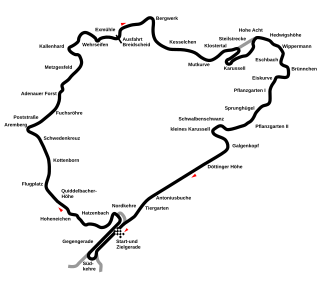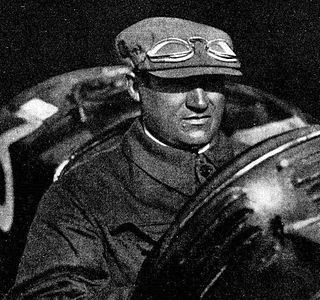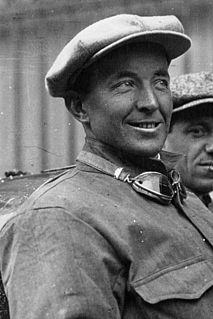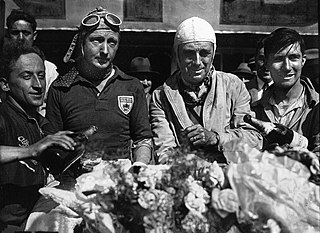
The 1951 German Grand Prix was a Formula One motor race held on 29 July 1951 at the Nürburgring Nordschleife. It was race 6 of 8 in the 1951 World Championship of Drivers.

Antonio Ascari was an Italian Grand Prix motor racing champion. He won four Grands Prix before his premature death at the 1925 French Grand Prix. He was the father of two-time World Champion Alberto Ascari.

Pietro Bordino was an Italian racecar driver.

The 1931 24 Hours of Le Mans was the 9th Grand Prix of Endurance that took place at the Circuit de la Sarthe on 13 and 14 June 1931.

The 1931 Grand Prix season was a watershed year, with the advent of the AIACR European Championship. After several years of Grand Prix racing in the doldrums with little technical development, 1931 saw new models come from all three main manufacturers: Bugatti, Maserati and Alfa Romeo.

The 1932 Grand Prix season marked the second year of the AIACR European Championship. It saw the debut of Alfa Romeo's sensational new Tipo B and with it, Tazio Nuvolari won the Championship driving for the Alfa Corse works team. The 40-year old Nuvolari won two of the three rounds and was second in the other. Still running to a Formula Libre rules for the cars, the regulations were revised to set the races to be between five and ten hours. However, all three national committees ran their races to the minimum time-limit.
The 1925 Grand Prix season was a watershed year in motor racing. It was the first year for the new AIACR World Manufacturers' Championship season. The championship was won by Alfa Romeo, with its P2 model.

The 1926 Grand Prix season was the second AIACR World Manufacturers' Championship season and the first running to new 1.5-litre regulations. The championship was won by Bugatti and its Type 35 was the dominant car of the year.

The 1927 Grand Prix season was the third AIACR World Manufacturers' Championship season and the second run to a 1.5-litre engine limit. In a dominant display, the championship was won by Delage, with team driver Robert Benoist winning four of the five Grand Prix.

The 1928 Grand Prix season saw the Monegasque driver Louis Chiron, and his Bugatti, take seven Grand Prix victories.

The 1921 Grand Prix season saw motor racing in Europe blossom again. The French Grand Prix was held for the first time since 1914, at La Sarthe, Le Mans. and the inaugural Italian Grand Prix was held in Montichiari, near Brescia. The 3-litre formula of the AIACR, already in use at Indianapolis, was adopted by those Grand Prix meaning manufacturers could design on a common formula.

The 1922 Grand Prix season had several notable events during the year. The AIACR governing body brought in a 2-litre formula for Grand Prix. French companies brought out straight-8 engines for their cars but it was FIAT's 6-cylinder engine that took the trophies. Veteran Felice Nazzaro won the French Grand Prix, held near Strasbourg. It was a tainted victory though, as Nazzaro's nephew was killed when his FIAT's suspension broke in the latter stages of the race. An almost identical accident also happened to team-mate Pietro Bordino, though he was only slightly injured. Pierre de Vizcaya's Bugatti finished second, nearly an hour behind.

The 1923 Grand Prix season was part of a watershed year for motor racing that saw significant advances in motor-racing engineering, design and events. Fiat's chief designer, Guido Fornaca, developed the 805, the first supercharged car to win a Grand Prix. Benz appeared with the first mid-engined racer and, along with Bugatti and Voisin, produced some of the first efforts at aerodynamics on racing cars. With the United States also adopting the 2-litre formula, Harry Miller could use the smaller engine size to design the first single-seater race-car, ideally suited to American oval racing.

The 1924 Grand Prix season saw Grand Prix motor racing spread further across Europe and North America. In Italy a number of new open-road events were held. In France two new circuits were opened – at Montlhéry near Paris and Miramas near Marseille.
The 1929 Grand Prix season was another interim year, where most races were run to Formula Libre rules due to a lack of regulations from the AIACR that would be popular for race organisers and manufacturers. This blurred the line between racing cars and sports cars with both competing in the same races. Bugatti won the major international races, with their drivers Louis Chiron and "W Williams". The Italian Championship proved very competitive, attracting many top drivers. There it was Alfa Romeo, using their 4-year old P2 model that claimed more victories, than their main competition coming from Bugatti and Maserati.
The 1930 Grand Prix season continued the malaise that had taken over the sport. Although there was little technical advance more privateer teams were forming, getting some factory support. The AIACR continued to mandate its fuel-regulated Formula Libre rules. Across the Atlantic, the AAA abandoned the AIACR regulations. Their new regulations were derisively called the “Junk Formula” by purists, opening up to their own version of Formula Libre: with modified stock-standard cars of up to 366 cu in (6-litres) with two seats.

The 1923 French Grand Prix was a Grand Prix motor race held at Tours on 2 July 1923. The race was run over 35 laps of the 22.83 km circuit for a total distance of just under 800 km and was won by Henry Segrave driving a Sunbeam. This race is notable as the first Grand Épreuve to be won by either a British driver or a British car. The race also featured several innovative new technologies, including the first appearance of both supercharging and V12 engines in Grand Prix racing.

The 1925 French Grand Prix was a Grand Prix motor race held at Autodrome de Linas-Montlhéry on 26 July 1925. It was the third race of the inaugural AIACR World Manufacturers' Championship. The race, which was 80 laps, was won by Robert Benoist driving a Delage 2LCV after starting from 8th place.
The first Grand Prix of theRoyal Automobile Club, commonly referred to as the 1926 British Grand Prix was a Grand Prix motor race held at the Brooklands circuit on 7 August 1926.

The 1933 French Grand Prix was a Grand Prix motor race which was run on 11 June 1933, in Montlhéry, France. Organized by the French Automobile Club, it was XXVII running of the Grand Prix de l'Automobile Club de France. The race, which was held over 40 laps, was won by the Italian driver Giuseppe Campari in a privately entered Maserati. It was to be Campari's final victory, as he was killed just three months later at Monza. Philippe Étancelin and George Eyston, both in privateer Alfa Romeos, finished in second and third, respectively.















